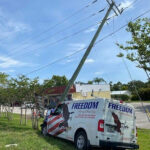VERO BEACH — City of Vero Beach Acting Electric Utility Director John Lee has stated what we all knew would be true: Despite urging on all fronts to get rates down, electric bills will go no lower for utility customers under the city’s current business plan.
In fact, bills will go up by $2.50 per 1,000 kilowatt hours in September when a current rebate expires, and they might go up even more in the short term due to increased transmission fees imposed for using Florida Power & Light lines to bring power to the city’s 33,000-plus customers.
In short, Lee said the city is pretty much stuck with its current expenses, unless the Council is prepared to impose less-robust staffing and pared down services going forward.
“This is as low as we can legitimately go without making major changes in our operations,” Lee said. “We are where we will be going forward.”
Local utility activist and CPA Glenn Heran, who along with Dr. Stephen Faherty has analyzed and presented financial data about the electric utility for about two years, was not surprised to hear John Lee’s statements that the city’s electric rates would go no lower than $121.45 ($123.95 after the rebate ends) per 1,000 kilowatt hours without a drastic change in the business plan.
“The city, and city staff specifically, has finally come forward with accurate and realistic information for the City Council and the public regarding electric rates,” Heran said. “Instead of what we were told for the past four years — that we could and would have competitive rates, rates equal to or less than Florida Power and Light — they’re coming clean with the facts.”
To Heran, the city’s inability, now or in the future, to achieve rates anywhere near the $92 for 1,000 kilowatt hours charged by FP&L makes it clear that selling — or even giving away — the utility to FP&L in exchange for 35 percent lower rates is the only logical answer.
Still, at just about every meeting, Lee presents color graphs and charts showing that the Vero utility is 10th in the state among municipal utilities, and that there are dozens of these mom-and- pop utilities that are now more expensive in the Florida. He lauds the great improvement from 2009, when Vero was runner-up for most expensive electricity in the Sunshine State. “There’s about $74.40 of the bill that you can’t do much about and the other $45, these are where you have more control over,” Lee said. “To get farther down, particularly if you do more than 4 to 5 percent is definitely going to take a complete remake of the way we operate the system.”
Heran agrees with Lee that only about 36 percent of customers’ electric bills is within the city’s control, but added, “That control is limited. There are certain minimum and fixed costs associated with this 36 percent that cannot be reduced in any material way.”
The balance of the bill pays for the city’s base-load generation — power from the St. Lucie nuclear plant and Stanton I and II coal plants — for staff, operation of the power plant, transmission wheeling fees and power from the Orlando Utilities Commission, which the City has no control over.
When a request for nearly $1.3 million to fix Unit 5 at the power plant came up for approval and failed, a somewhat surprised City Council found out that shuttering the power plant to save money isn’t even an option. “Can’t we buy power to meet our load charged to us, so we can opt out of Unit 5,” Councilman Brian Heady asked of staff. A flat-out “no” was the answer.
Lee told the Council that “the OUC contract includes running units five and two as part of the contract,” and that was backed up by Jim Stevens, who runs the power plant. Stevens said the units are fired up first to meet the city’s needs, but added that the Florida Municipal Power Pool also requires the city’s generators be available to send power to the grid if need be.
According to the city budget, it seems that it costs about $24 million extra for the city to produce or purchase the same power that its customers could get from FP&L for $24 million less — providing the negotiation of FP&L retail rates, which would most likely be required by the Florida Public Service Commission anyway under the premise of fairness.
“To get rates comparable to Florida Power and Light, Steve and I have shown that the City would have to nearly get the OUC wholesale power for free,” Heran said.
This conundrum is now regularly mentioned by Councilman Brian Heady and also by District 2 County Commission candidate Charlie Wilson, a staunch advocate for getting the city out of the electric business. “Do you have in mind a different business model that would result in lower rates to the customers?” Heady asked Lee.
Lee has tossed out a few options for cutting bills, namely cutting customer service staff and tightening up on past due balances. He said not having a staffed office is a possibility. Florida Power & Light contracts with local businesses to act as collection points for bills, but does not have a local customer service office. This approach could save salaries and pensions, but would result in layoffs.
The electric utility currently contributes about $1.8 million toward shared employees in administration, plus the finance, legal and information technology departments. This accounts for about 2 percent of bills, or roughly $2.50 per 1,000 kilowatt hours.
“I’m not in agreement with Mr. Lee that we can’t go lower,” Councilman Ken Daige said. “The benchmark is FP&L. I know we can’t get down to $92 but we need to work to bring it down. I know you’re working hard with your staff, but we’ve got to bring it down.”
“We will have to reassess our entire business model and the way we do things,” Lee said in response to Daige. “We’re very concerned about our customers.”
Another option not discussed at the meeting but brought up previously by Mayor Kevin Sawnick, which would shave between 5 and 6 percent from bills, would be to eliminate the $5.9 million annual transfer from the electric utility into the general fund. Such a move would require a huge increase in property taxes for homeowners inside the city limits, but, according to Heran’s models would still keep rates about 26 percent higher than FP&L.
It also would continue to penalize county and Shores residents with little savings for city customers.






